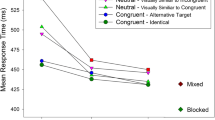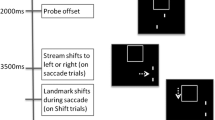Abstract
The present study examined the recently proposed two-process model of localization performance in which a shift of attention, providing coarse location information, is followed by a saccadic eye movement, providing fine location information. In experiment 1 the nature of the localization response was manipulated. In contrast to the indirect response mode used in the study by Adam et al., i.e., manipulating the “arrow” keys to move the cursor to the target location, experiment 1 required subjects to point to the target location. The high degree of similarity between the pattern of results obtained with the pointing and cursor response indicated that performance in the localization paradigm was not differentially affected by the nature of the required response. In experiment 2 the characteristics of the backward masking stimulus was manipulated by employing three masking conditions: (1) a long-duration mask; (2) a short-duration mask (100 ms); and (3) a nomask condition. Results showed that the long-duration mask caused interference at short and facilitation at long intervals between onset of target and mask; the short-duration mask caused interference only at short intervals. Overall the findings were consistent with the two-process model of localization performance.
Similar content being viewed by others
References
Adam JJ, Ketelaars M, Kingma H, Hoek T (1993) On the time course and accuracy of spatial localization: basic data and a two-process model. Acta Psychol 84:135–159
Bergen JR, Julesz B (1983) Parallel versus serial processing in rapid pattern discrimination. Nature 303:696–698
Breitmeyer BG (1984) Visual masking: an integrative approach. Clarendon Press, Oxford
Breitmeyer BG, Ganz L (1976) Implications of sustained and transient channels for theories of visual pattern masking, saccadic suppression, and information processing. Psychol Rev 83:1–36
Coltheart M (1980) Iconic memory and visible persistence. Percept Psychophys 27:183–228
Di Lollo V (1980) Temporal integration in visual memory. J Exp Psychol Gen 109:75–97
Eriksen CW (1990) Attentional search of the visual field. In: Brogan D (ed) Visual search. Taylor and Francis, London, pp 3–19
Eriksen CW, Schultz DW (1978) Temporal factors in visual information processing: a tutorial review. In: Renquin J (ed) Attention and performance VII. Erlbaum, Hillsdale, N. J. pp 3–23
Eriksen CW, Schultz DW (1979) Information processing in visual search: a continuous flow conception and experimental results. Percept Psychophys 25:249–263
Fisher B, Breitmeyer B (1987) Mechanisms of visual attention revealed by saccadic eye movements. Neuropsychologia 25:73–83
Goldberg ME, Wurtz RH (1972) Activity of superior colliculus in behaving monkeys: II. Effects of attention on neuronal response. J Neurophysiol 35:560–574
Klein SA, Levi DM (1987) Position sense of the peripheral retina. J Opt Soc Am [A] 4:1543–1553
Kulikowski JJ, Tolhurst DJ (1973) Psychological evidence for sustained and transient detectors in human vision. J Physiol (Lond) 232:149–162
Latto R (1982) Visual perception and oculomotor areas in the primate brain. In: Ingle DJ, Goodale MA, Mansfield RJW (eds) Advances in the analysis of visual behavior. MIT Press, Boston, pp 671–691
McClelland JL (1979) On the time relations of mental processes: an examination of processes in cascade. Psychol Rev 86:287–330
Morgan MJM, Watt RJ (1989) The Weber relationship for position is not an artefact of eccentricity. Vision Res 29:1457–1463
Müller HJ, Rabbitt PMA (1989) Reflexive and voluntary orienting of visual attention: time course of activation and resistance to interruption. J Exp Psychol Hum Percept Perform 15:315–330
Nelson TO, Chaiklin S (1980) Immediate memory for spatial location. J Exp Psychol Learn 6:529–545
Posner MI, Petersen SE (1990) The attention system of the human brain. Annu Rev Neurosci 13:25–42
Remington RW, Johnston JC, Yantis S (1992) Involuntary attentional capture by abrupt onsets. Percept Psychophys 51:279–290
Rizzolatti G, Riggio L, Dascola I, Umiltá C (1987) Reorienting attention across the horizontal vertical meridians: evidence in favour of a premotor theory of attention. Neuropsychologia 25:31–40
Sadalla EK, Burroughs WJ, Staplin LJ (1980) Reference points in spatial cognition. J Exp Psychol Learn Mem Cogn 6:516–528
Shepherd M, Findlay J, Hockey R (1986) The relationship between eye movements and spatial attention. Q J Exp Psychol [A] 38:475–491
Styles EA, Allport DA (1986) Perceptual integration of identity, location and colour. Psychol Res 48:189–200
Todd JT, Van Gelder P (1979) Implications of a transient-sustained dichotomy for the measurement of human performance. J Exp Psychol Hum Percept Perform 5:625–638
Treisman AM, Gelade G (1980) A feature-integration theory of attention. Cognitive Psychol 12:97–136
Turvey M (1973) On peripheral and central processes in vision: inferences from an information-processing analysis of masking with patterned stimuli. Psychol Rev 80:1–52
Westheimer G (1982) The spatial grain of the perifoveal visual field. Vision Res 22:157–162
White JM, Levi DM, Aitsebaomo AP (1992) Spatial localization without visual references. Vision Res 32:513–526
Wong E, Mack A (1981) Saccadic programming and perceived location. Acta Psychol 48:123–131
Wurtz RH, Mohler CW (1976) Organization of monkey superior colliculus: enhanced visual response of superficial layer cells. J Neurophysiol 39:745–765
Yantis S, Yonides J (1984) Abrupt visual onsets and selective attention: evidence from visual search. J Exp Psychol Hum Percept Perform 10:601–621
Author information
Authors and Affiliations
Rights and permissions
About this article
Cite this article
Adam, J.J., Paas, F.G.W.C., Ekering, J. et al. Spatial localization: tests of a two-process model. Exp Brain Res 102, 531–539 (1995). https://doi.org/10.1007/BF00230657
Received:
Accepted:
Issue Date:
DOI: https://doi.org/10.1007/BF00230657




